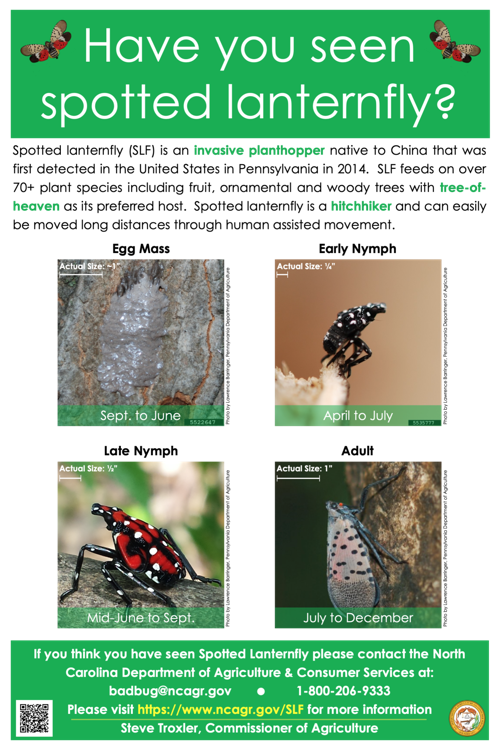Public urged to keep an eye out for spotted lanternflies as they eat their way south
Agriculture officials are asking the public to keep an eye out for the spotted lanternfly, an invasive species that poses a significant threat to woody plants and a nuisance to people and property. In North Carolina, Guilford and Forsyth counties are officially labeled as having infestations. Spotted lanternflies have been found in 14 other counties, including Onslow and Currituck in the east.
Spotted lanternfly nymphs are hatching now. The youngest ones are about 1/4-inch long with black bodies and white spots. As they grow, these nymphs will reach 3/4-inch in length and change colors, becoming a striking red with white spots starting about mid-June.
Native to China, India and Vietnam, they primarily feed on sap from woody plants. Grapevines and tree of heaven, another import from Asia, are favorites. Infestations can weaken and eventually kill plants.
“They like the black walnut. They like a lot of maple species,” said Mirian Watts, an entomologist and teaching assistant professor of biology at East Carolina University. “And they like grapes. So that is the concern on the economic side … where they could cause loss, they could cause farmers to spend a lot more money” on control measures.
Adults begin emerging around July and are about an inch long and half an inch wide. Their wings are grayish-white with black spots, and the abdomen is yellow with black stripes. Part of their hindwings are also bright red with black spots. The wings are held folded over their backs when the insects are at rest. Its six legs are black with white bands, and the feet are clawed. Its head is black with two large eyes and two small antennae.
Watts cited predictions the insects will soon cover most of the eastern U.S. and by 2033 extend west to California.
“Early in the infestations, it was believed they could not fly,” she said, but further investigations have shown they can. “They can travel up to 10 miles in a year, and they can spread. It’s at a point where we don’t have a hope to eliminate them anymore because it’s so hard to find the eggs.”
The dark gray egg masses blend in with tree bark, rocks, concrete and other materials. They also can be as much as 70 feet high. That makes it hard to have an effective plan for chemical control, she said, since once the nymphs or adults are spotted the infestation is already underway.
To combat the spread of the insects, officials are urging the public to report any sightings to the N.C. Department of Agriculture and Consumer Services. People are also encouraged to remove any egg masses they find on trees, rocks or other surfaces and use sticky bands around tree trunks to trap the insects or kill them.
Spotted lanternflies were first discovered in the United States in 2014 in southeastern Pennsylvania. Since then, they have spread west as far as Indiana and south into Virginia and North Carolina, according to New York State Integrated Pest Management at Cornell University, a leading source of information about the pest.
Once they hatch, the nymphs are a nuisance as well as a serious threat to economic crops.
Watts said people shouldn’t worry about any environmental or other impact of killing the insects.
“We should come back to what is an invasive species,” she said. “They might be pretty, but they are causing harm to that native plant. That plant is suffering. That plant can actually die.
“They do have a natural habitat where they are out and about and they cause no harm to anybody or anything, and that’s where they should be. But here they are causing different problems, and they should not be around.”
####
East Carolina University News Services
Howard House, 1001 E. Fifth St.
Greenville, NC 27858
ecunews@ecu.edu
Phone: 252-328-6481
news.ecu.edu
